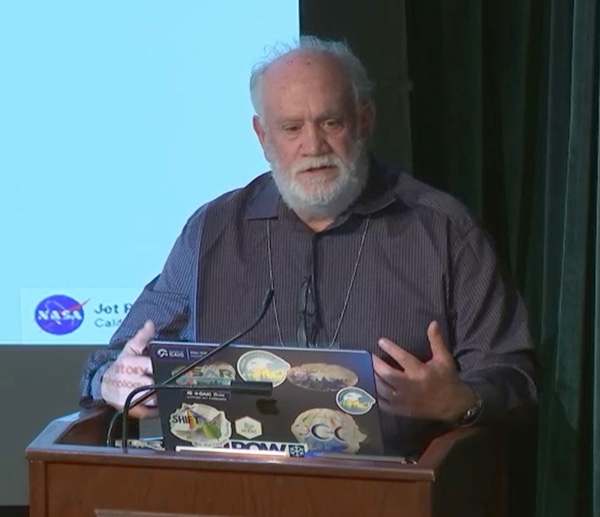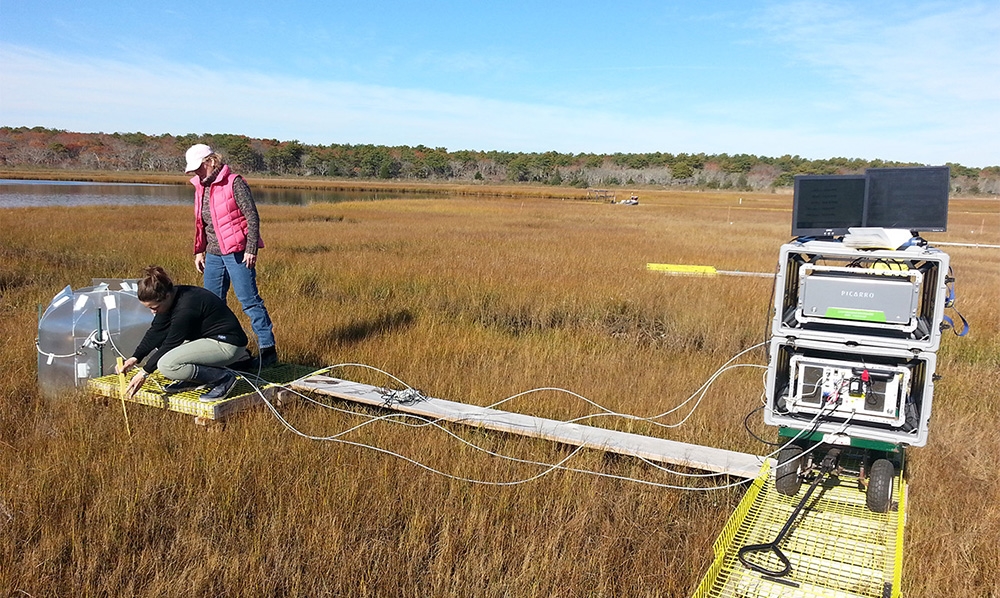From Space to Woods Hole: Satellite Data Offers Picture of Earth’s Carbon Future

This year marks the 50th anniversary of the MBL Ecosystems Center. To recognize this milestone, the MBL Communications team is highlighting several talks from the center’s anniversary symposium, held in late May.
In this article, we focus on the keynote address from David Schimel, a group leader and research scientist at NASA’s Jet Propulsion Laboratory and a former MBL research associate working with Distinguished Scientist Jerry Melillo in the Ecosystems Center.
Schimel, Melillo, and other scientists working with the Intergovernmental Panel on Climate Change (IPCC) were co-recipients with Al Gore Jr. of the 2007 Nobel Peace Prize.
Life on Earth is centered around carbon. An element that forms the backbone of organic molecules, carbon is prevalent inside the bodies of animals, plants and other organisms. It also cycles between the atmosphere and Earth’s ecosystems, which has major impacts on the planet’s climate.
The Marine Biological Laboratory (MBL) Ecosystems Center has studied the carbon cycle since the center’s founding in 1975. But projecting what will happen to this cycle as the climate continues to warm is tricky.
“The more we know, the more we [realize] how little we understand about how it actually works,” said David Schimel of NASA’s Jet Propulsion Laboratory, in his keynote address at the Ecosystem Center’s 50th Anniversary Symposium.
The carbon cycle is particularly mysterious in terrestrial ecosystems, he said, and projections are so sensitive to initial assumptions “that reasonably credible models are still predicting wildly different terrestrial carbon futures.”
The issue stems, in part, from a lack of data — a challenge that space-based solutions can address. Satellite measurements can provide scientists with detailed information on landscape features such as plant physiology and forest structure, Schimel wrote in an email, that “move models from being a ‘cartoon’ of our real world to more like a ‘photograph.’”

Understanding the Climate Control Knob
The carbon cycle is driven by global biological processes such as photosynthesis and cellular respiration, through which organisms either absorb or release carbon dioxide. Human activities such as burning fossil fuels or clear-cutting forests for agriculture also change the amount of carbon entering or exiting the atmosphere.
Net flux is a measure of the carbon being absorbed and released by an ecosystem, often at the same time. Towering above the landscape, eddy covariance flux towers measure the concentration of greenhouse gases being carried by eddies, or bursts of wind. Scientists use data from these towers, along with other methods, to project how the carbon cycle might behave in the future.
But a closer look reveals these data collection methods sample just a sliver of the planet. Eddy covariance towers survey a tiny fraction of 1 percent of Earth’s land surface, Schimel said, and other tools for measuring aspects of the carbon cycle, such as comparing changes in soil profiles and forest inventory plots, are similarly limited in their coverage to less than 1 percent of the land's surface. Computer models designed to predict the carbon cycle base their projections on what researchers tell the models about Earth. Much like a calculator is only as accurate as the numbers typed into it, a model with only broad — or inaccurate — knowledge of the planet will not project the future as well as one with more detailed information.
Satellite technology can fill these gaps. The International Space Station houses the GEDI Lidar, an instrument that uses lasers to measure physical features of forests, and ECOSTRESS, a system that monitors evaporation and transpiration (water vapor loss from plant leaves). Both cover about three-quarters of Earth’s land surface, Schimel said, and polar-orbiting satellites like Terra and Aqua can survey essentially all of Earth’s land surface.
As valuable as these satellites are, global ecology is more than “downloading data onto computer screens,” he cautioned. Schimel's current research focuses on the tropics, which store a significant amount of carbon. He and his team spent a month in Panama earlier this year, collecting over 1,000 foliage samples for chemical, genomic and other analyses.
Optical satellites measure the light bouncing back into space from Earth, Schimel said, and field studies can help researchers interpret that data to infer plant chemistry, physiology and species identity.
“By combining space-based information with good old-fashioned fieldwork and high-tech flux towers, we should be able to reduce the uncertainty about models of the future better and better, using the space-based data to knit things together,” Schimel said.

Better models should help us make more informed decisions on how to manage the carbon cycle, which Schimel called “the knob that humanity has to control the climate system.” The key to a stable climate is to reduce fossil emissions while also protecting Earth's carbon stocks, he said.
“Ecosystem science has done a good job of understanding impacts of climate change,” he said, “and now we have to understand how to minimize the vulnerability of ever-more valuable forests and soils to hold on to all the carbon they hold, and increase it where possible.”
Watch David Schimel’s keynote address at the MBL Ecosystems Center 50th Anniversary Symposium here.
An Ecosystem of Impact
The MBL Ecosystems Center was founded in 1975 by George Woodwell. At the time, Woodwell held the controversial belief that deforestation was contributing significantly to carbon emissions — a position that center scientists later proved correct.
In his talk at the Ecosystems Center’s 40th anniversary, David Schimel touched on landmark research in carbon cycle science, noting that multiple milestone studies were either done by MBL scientists or inspired by them.
In the 1970s and 1980s, estimates for how human land-use change was impacting the carbon cycle varied widely, Schimel said. A team comprised primarily of Ecosystems Center researchers synthesized “massive amounts of data” to publish their own estimate in 1983; it is still within the range of the best satellite-fueled estimates today, he said.
Fifteen years later, a team from Princeton University and the National Oceanic and Atmospheric Administration (NOAA) published a paper that suggested a large terrestrial carbon sink — that is, large annual uptake and storage of carbon — existed in North America. MBL scientists were once again there to set the record straight: former Ecosystems Center Director Jerry Melillo initiated a series of papers arguing that the uptake of carbon by ecosystems was much less than initially thought.
Melillo's project, called VEMAP (Vegetation and Ecosystem Modeling and Analysis Project) was a very early effort to use process models and data together to understand the terrestrial carbon cycle, Schimel said.
From those pioneering efforts to the present day, the Ecosystems Center has had an outsized impact on the field of carbon science. The center’s influence extends to alumni like Schimel, who was an MBL research associate from 1977 to 1979 with Daniel Botkin and Melillo.
“Really, I think those two years — more than any other time, and certainly more than my time in graduate school — triggered the interests in science that I’ve carried throughout my career,” he said, “and probably more than any other time in my career made me the scientist, and maybe even the person, that I am.”